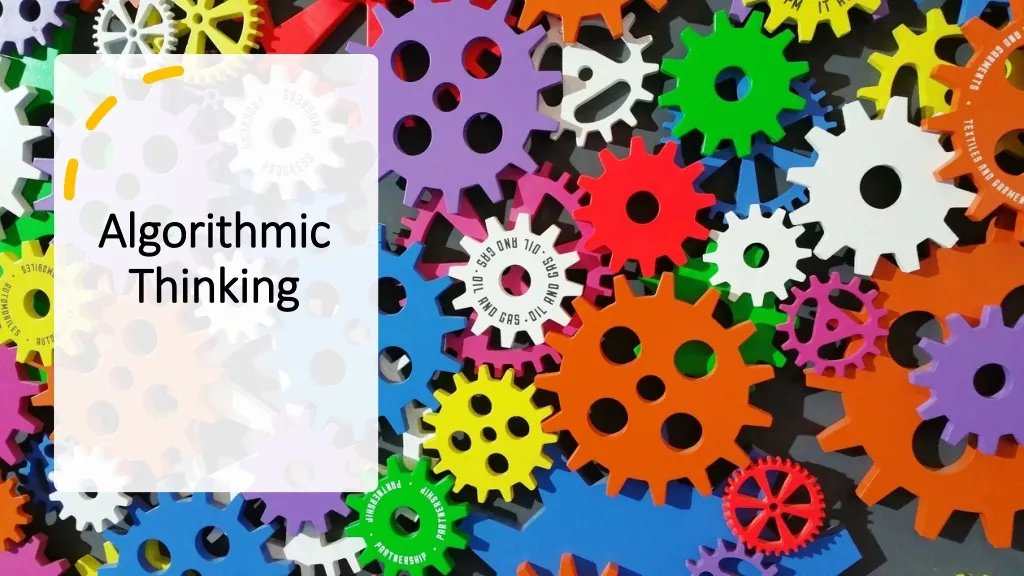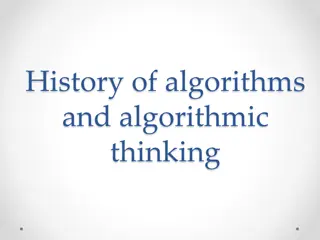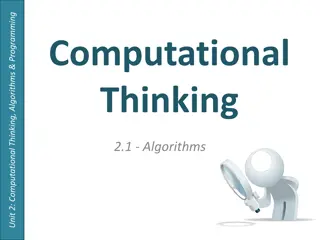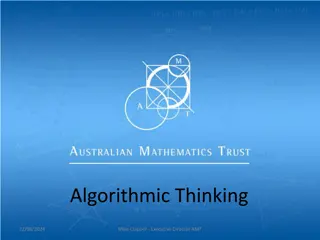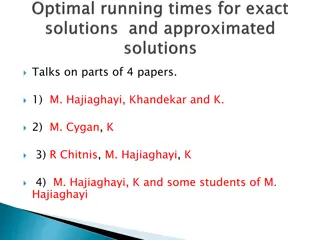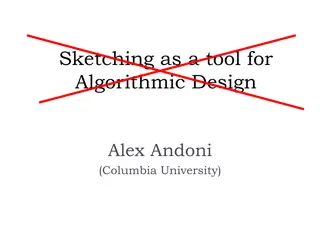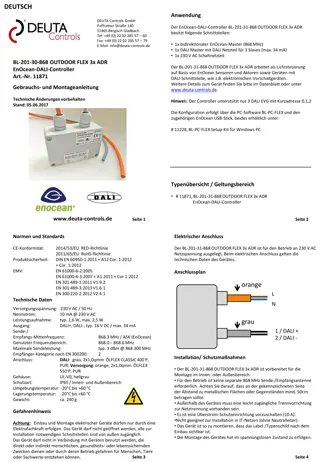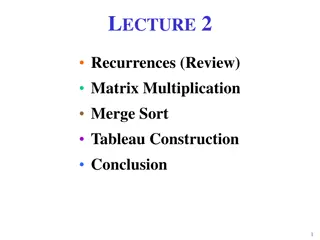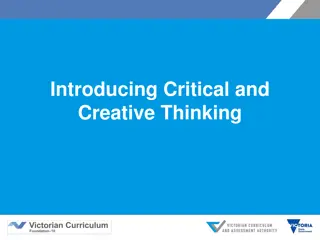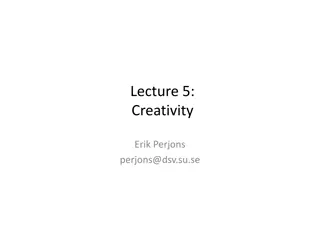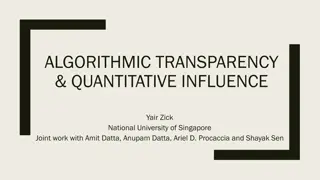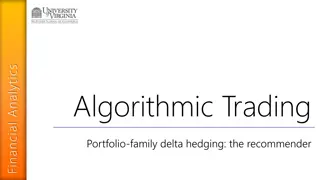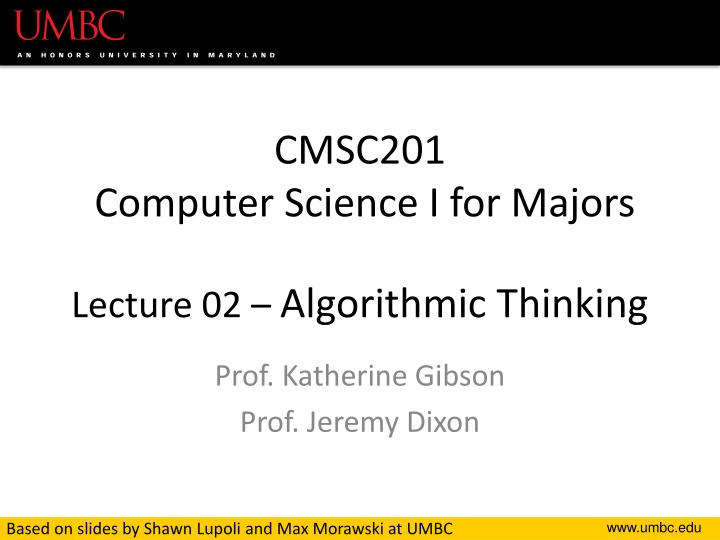
Algorithmic Thinking in Computer Science: Understanding and Developing Algorithms
Explore the fundamentals of algorithmic thinking in computer science, including defining an algorithm, developing algorithms step-by-step, and representing them using flowcharts or pseudocode. Learn how to solve problems systematically and logically, leading to efficient program development and implementation.
Download Presentation

Please find below an Image/Link to download the presentation.
The content on the website is provided AS IS for your information and personal use only. It may not be sold, licensed, or shared on other websites without obtaining consent from the author. If you encounter any issues during the download, it is possible that the publisher has removed the file from their server.
You are allowed to download the files provided on this website for personal or commercial use, subject to the condition that they are used lawfully. All files are the property of their respective owners.
The content on the website is provided AS IS for your information and personal use only. It may not be sold, licensed, or shared on other websites without obtaining consent from the author.
E N D
Presentation Transcript
CMSC201 Computer Science I for Majors Lecture 02 Algorithmic Thinking Prof. Katherine Gibson Prof. Jeremy Dixon www.umbc.edu Based on slides by Shawn Lupoli and Max Morawski at UMBC
Last Class We Covered Syllabus Grading scheme, expectations, etc. Academic Integrity Policy Computer System Components Binary numbers Converting between binary and decimal Algorithmic thinking Making sandwiches for aliens 2 www.umbc.edu
Any Questions from Last Time? www.umbc.edu
Todays Objectives To practice thinking algorithmically To understand and be able to implement proper program development To start learning about control structures To be able to express an algorithm using a flow chart 4 www.umbc.edu
What is an Algorithm? Steps used to solve a problem Steps must be Ordered Unambiguous Complete Problem must be Well defined Fully understood by the programmer 5 www.umbc.edu
Developing an Algorithm www.umbc.edu
Program Development 1. Understand the problem 2. Represent your solution (your algorithm) Pseudocode Flowchart 3. Implement the algorithm in a program 4. Test and debug your program 7 www.umbc.edu
Step 1: Understanding the Problem Input What information or data are you given? Process What must you do with the information/data? This is your algorithm! Output What are your deliverables? 8 www.umbc.edu
Weekly Pay Example Create a program to calculate the weekly pay of an hourly employee What is the input, process, and output? Input: pay rate and number of hours Process: multiply pay rate by number of hours Output: weekly pay 9 www.umbc.edu
Step 2: Represent the Algorithm Can be done with flowchart or pseudocode Flowchart Symbols convey different types of actions Pseudocode A cross between code and plain English One may be easier for you use that one 10 www.umbc.edu
Step 2A: Pseudocode Start with a plain English description, then 1. Display Number of hours worked: 2. Get the hours 3. Display Amount paid per hour: 4. Get the rate 5. Compute pay = hours * rate 6. Display The pay is $ , pay 11 www.umbc.edu
Flowchart Symbols Start Start Symbol Input/Output End End Symbol Decision Symbol Data Processing Symbol Flow Control Arrows 12 www.umbc.edu
Step 2B: Flowchart Start Get the rate Display Number of hours worked: pay = hours * rate Display The pay is $ , pay Get the hours Display Amount paid per hour: End 13 www.umbc.edu
Steps 3 and 4: Implementation and Testing/Debugging We ll cover implementation in detail next class Testing and debugging your program involves identifying errors and fixing them We ll talk about this later today 14 www.umbc.edu
Algorithms and Language Notice that developing the algorithm didn t involve any Python at all Only pseudocode or a flowchart was needed An algorithm can be coded in any language All languages have 3 important control structures we can use in our algorithms 15 www.umbc.edu
Control Structures www.umbc.edu
Control Structures Structures that control how the program flows or operates, and in what order Sequence Decision Making Looping 17 www.umbc.edu
Sequence One step after another, with no branches Already wrote one for Weekly Pay problem What are some real life examples? Dialing a phone number Purchasing and paying for groceries 18 www.umbc.edu
Decision Making Selecting one choice from many based on a specific reason or condition If something is true, do A if it s not, do B What are some real life examples? Walking around campus (construction!) Choosing where to eat lunch 19 www.umbc.edu
Decision Making: Pseudocode Answer the question Is a number positive? Start with a plain English description 1. Display Enter the number: 2. Get the number (call it num) 3. If num > 0 4. Display It is positive 5. Else 6. Display It is negative 20 www.umbc.edu
Decision Making: Flowchart Display Enter the number: Get the number Start FALSE TRUE num > 0 Display It is positive Display It is negative End 21 www.umbc.edu
Looping Doing something over and over again Used in combination with decision making Otherwise we loop forever This is called an infinite loop What are some real life examples? Doing homework problem sets Walking up steps 22 www.umbc.edu
Looping: Pseudocode Write an algorithm that counts from 1-20 Start with a plain English description 1. Set num = 1 2. While num <= 20 3. Display num 4. num = num + 1 5. (End loop) 23 www.umbc.edu
Looping: Flowchart Start num = 1 There s an error in this flowchart do you see it? Display num TRUE num = num + 1 num >= 20 num >= 20 FALSE End 24 www.umbc.edu
Looping: Flowchart Start num = 1 Display num TRUE num = num + 1 num <= 20 FALSE End 25 www.umbc.edu
Debugging www.umbc.edu
A Bit of History on Bugs US Navy lab September 9, 1947 Grace Hopper and her colleagues were working on the Harvard Mark II Or trying to it wasn t working right They found a literal bug inside the machine Taped the bug (a moth) into their log book 27 www.umbc.edu
Errors (Bugs) Two main classifications of errors Syntax errors Prevent Python from understanding what to do Logical errors Cause the program to run incorrectly, or to not do what you want 28 www.umbc.edu
Syntax Errors Syntax is the set of rules followed by a computer programming language Similar to grammar and spelling in English Examples of Python s syntax rules: Keywords must be spelled correctly True and False, not Ture or Flase or Truu Quotes and parentheses must be closed: ("Open and close") 29 www.umbc.edu
Syntax Error Examples Find the syntax errors in each line of code below: 1 prnit("Hello") 2 print("What"s up?") 3 print("Aloha!) 4 print("Good Monring") 30 www.umbc.edu
Syntax Error Examples Find the syntax errors in each line of code below: 1 prnit("Hello") 2 print("What"s up?") 3 print("Aloha!) 4 print("Good Monring") not actually a syntax error 31 www.umbc.edu
Logical Errors Logical errors don t bother Python at all they only bother you! Examples of logical errors: Using the wrong value for something currentYear = 2013 Doing steps in the wrong order Close jelly jar. Put jelly on bread. Open jelly jar. 32 www.umbc.edu
Exercise Write an algorithm that asks a user for their name, then responds with Hello NAME You can use a flowchart or pseudocode Start Input/Output Decision End Flow Control Data Processing 33 www.umbc.edu
Exercise #2 Write an algorithm that asks a user for their grade, and tells them their letter grade. A: 100 - 90 B: <90 - 80 C: <80 - 70 D: <70 - 60 F: <60 - 0 Start Input/Output Decision End Flow Control Data Processing 34 www.umbc.edu
Announcements Your Lab 0 is an in-person lab this week! You need to go to your labs during your assigned lab time Homework 1 is out Due by next Monday (Feb 8th) at 8:59:59 PM Both of these assignments are on Blackboard 35 www.umbc.edu
Practice Problems Complete the 2 exercises on the previous slides Modify our count to 20 algorithm so that it counts from 0 to 100, in increments of 5 Design an algorithm that finds the average of three exam scores (pseudocode or flowchart) Advanced: Design an algorithm that asks the user for two numbers, and then asks them if they want to multiply, add, or subtract the numbers from each other; perform the operation the user wanted, and show them the result 36 www.umbc.edu

